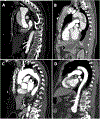Diagnosis and Management of Acute Aortic Syndromes: Dissection, Penetrating Aortic Ulcer, and Intramural Hematoma
- PMID: 35029783
- PMCID: PMC9834910
- DOI: 10.1007/s11886-022-01642-3
Diagnosis and Management of Acute Aortic Syndromes: Dissection, Penetrating Aortic Ulcer, and Intramural Hematoma
Abstract
Purpose of review: Acute aortic syndromes, including aortic dissection, intramural hematoma, and penetrating aortic ulcer, are a group of highly morbid, related pathologies that are defined by compromised aortic wall integrity. The purpose of this review is to summarize current management strategies for acute aortic syndromes.
Recent findings: All acute aortic syndromes have potential for high morbidity and mortality and must be quickly identified and managed with the appropriate algorithm to prevent suboptimal outcomes. Recent trials suggest that TEVAR is increasingly useful in stabilizing pathology of the descending thoracic aorta but when possible should be applied in a delayed fashion and with limited coverage to minimize neurologic complications. Treatment for acute aortic syndrome is frequently dictated by the anatomic location and extent of the wall compromise as well as patient comorbidities. Therapy is often individualized and often includes some combination of medical, procedural, and surgical intervention.
Keywords: Acute aortic syndrome; Aortic dissection; Intramural hematoma; Penetrating aortic ulcer; TEVAR; Type B dissection.
© 2022. The Author(s), under exclusive licence to Springer Science+Business Media, LLC, part of Springer Nature.
Conflict of interest statement
Figures
References
-
- Bonaca MP, O’Gara PT. Diagnosis and management of acute aortic syndromes: dissection, intramural hematoma and penetrating aortic ulcer. Curr Cardiol Rep. 2014:16:536. - PubMed
-
- Mussa FF, Horton JD, Moridzadeh R, et al. Acute aortic dissection and intramural hematoma: a systematic review. JAMA. 2016:316(7):754–63. - PubMed
-
- Harris KM, Strauss CE, Eagle KA, et al. Correlates of delayed recognition and treatment of acute type A aortic dissection: the International Registry of Acute Aortic Dissection (IRAD). Circulation. 2011:124:1911–8. - PubMed
-
- Abdulameer H, Al Tail H, Al-Kindi SG, et al. Epidemiology of fatal ruptured aortic aneurysms in the United States (1999–2016). J Vase Surg. 2019:69:378–84. - PubMed
-
- Virani SS, Alonso A, Aparicio HJ, et al. Heart disease and stroke statistics—2021 update: a report from the American Heart Association. Circulation. 2021;143(8):e254–e743. - PubMed
Publication types
MeSH terms
Grants and funding
LinkOut - more resources
Full Text Sources
Research Materials


